Third place
 From Wikipedia - Reading time: 12 min
From Wikipedia - Reading time: 12 min
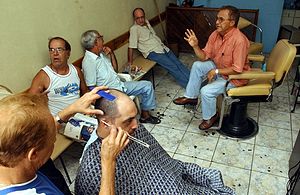
In sociology, the third place refers to the social surroundings that are separate from the two usual social environments of home ("first place") and the workplace ("second place"). Examples of third places include churches, cafes, bars, clubs, libraries, gyms, bookstores, hackerspaces, stoops, parks, theaters, among others. In his book The Great Good Place (1989), Ray Oldenburg argues that third places are important for democracy, civic engagement and a sense of place. Oldenburg's coauthor Karen Christensen argues in the 2025 sequel that third places are the answer to loneliness, political polarization, and climate resilience. She also clarifies the difference between third places and public spaces.
Oldenburg and Christensen's characteristics of third places
[edit]Oldenburg called one's "first place" the home and the people the person lives with. The "second place" is the workplace—where people may actually spend most of their waking time. Third places, then, are "anchors" of community life and facilitate and foster broader, more creative interaction.[1] In other words, "your third place is where you relax in public, where you encounter familiar faces and make new acquaintances."[2]
In the original 1989 The Great Good Place, Oldenburg summarised his view of a third place with eight characteristics:
- Neutral ground
- Occupants of third places have little to no obligation to be there. They are not tied down to the area financially, politically, legally, or otherwise and are free to come and go as they please.
- Leveler (a leveling place)
- Third places put no importance on an individual's status in a society. One's socioeconomic status does not matter in a third place, allowing for a sense of commonality among its occupants. There are no prerequisites or requirements that would prevent acceptance or participation in the third place.
- Conversation is the main activity
- Playful and happy conversation is the main focus of activity in third places, although it is not required to be the only activity. The tone of conversation is usually light-hearted and humorous; wit and good-natured playfulness are highly valued.
- Accessibility and accommodation
- Third places must be open and readily accessible to those who occupy them. They must also be accommodating, meaning they provide for the wants of their inhabitants, and all occupants feel their needs have been fulfilled.
- The regulars
- Third places harbor a number of regulars that help give the space its tone, and help set the mood and characteristics of the area. Regulars to third places also attract newcomers, and are there to help someone new to the space feel welcome and accommodated.
- A low profile
- Third places are characteristically wholesome. The inside of a third place is without extravagance or grandiosity, and has a cozy feel. Third places are never snobby or pretentious, and are accepting of all types of individuals, from various different walks of life.
- The mood is playful
- The tone of conversation in third places is never marked with tension or hostility. Instead, third places have a playful nature, where witty conversation and frivolous banter are not only common, but highly valued.
- A home away from home
- Occupants of third places will often have the same feelings of warmth, possession, and belonging as they would in their own homes. They feel a piece of themselves is rooted in the space, and gain spiritual regeneration by spending time there.
Historical examples
[edit]The term "third place" itself was first established in the book The Great Good Place (1989), written by the sociologist Ray Oldenburg. Locales of this type have been identified throughout human history.
Ancient Greek agora
[edit]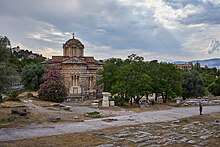
Ancient Greeks and their agora, or public squares,[3] are among some of the first well-documented communal spaces that could be considered a "third place". They served as marketplaces to exchange goods and currency, or engage in political debate. These gatherings would host people from all walks of life: political figures, poets, philosophers, and common folk, subsets of people that wouldn't have otherwise interacted as part of their daily routine.[4] Modern evolutions and derivations of the agora have remained prevalent in many subsequent civilizations. The term agoraphobia, or fear of open public spaces, originates from this grecian meeting spot.[4]
Imperial Chinese teahouses
[edit]Being defined as a separate physical sphere from one's home or place of work, teahouses were prevalent third places in society. Tea evolved into a functionally social drink in the ancient Jin Dynasty from the period 265-316AD. These shops allowed businessmen to conduct meetings in a discreet manner.[5] Time spent in these locations was used as a tool to show off of one's status and ability to spend money on simple luxuries. Teahouses would come to function as central meeting places and "instrumental fixture in the nucleus of provincial towns".[6]
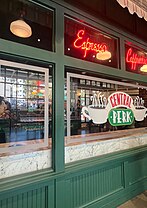
The European coffeehouse
[edit]Food and drink often have been closely associated with the idea of third places, being that they offer inciting motivation to attend, but wouldn't get in the way of conversation.[7] Not dissimilar to tea houses, the increasing popularity of coffeehouses during England's 17th Century became societal staples for community building. According to a UNESCO article co-written by Ray Oldenburg himself, "As places of free speech allowing a certain level of equality, coffeehouses can be seen as the precursors of democracy".[8] Coffee was a stimulant, in contrast to the depressor that was the rampant alcohol consumption before this point in English history. Thus, these coffee houses became "a real political arena".[8] They were referred to as "Penny Universities" in the way that they enabled attendees to expose themselves to intellectual fervor with no financial barrier of entry.[7][8]
Following into the 21st century, coffeeshops are still one of the most ubiquitous third places. These conversation hotspots have been reflected in media as hubs of human connection and belonging, like the Central Perk coffeeshop (Friends), or similarly the Cheers bar (Cheers).[9]
Types
[edit]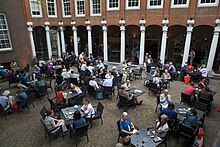
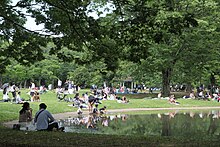

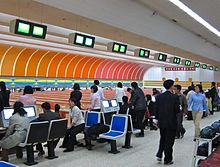
One of the criteria for the third place, according to Jeffres et al. (2009), is that it "offers stress relief from the everyday demands of both home and work. It provides the feeling of inclusiveness and belonging associated with participating in a group’s social activities, without the rigidity of policy or exclusiveness of club or organization membership".[10]
In their research, many types of environments were listed as possible third places. These included community centers like YMCAs and YWCAs; senior centers; shopping centers like coffee shops, malls, and barber shops; religious places; schools; outdoor recreative activities (parks, neighborhood parties); and various media such as the World Wide Web and newspapers.[10]
Oldenberg observed that, while many third places such as public parks are completely free, they often tend to be commercial establishments. However, Oldenberg emphasized that chain establishments run by large corporations are "less hardy" third places than local, independently-owned establishments, as they divert (cash) flow away from the local community to distant owners.[11]
The concept of a "third place" has been picked up by various small businesses, including as a name for various locally owned coffee shops, and is commonly cited in urban planning literature on the issue of community-oriented business development and public space.[12][13]
As the concept of "third place" has become more popular, several coworking office spaces have embraced this concept as the basis of their interior design.[14][15][16]
Variant forms of the concept include the "community coffee house" and the "community living room," a term which has been adopted by several organizations[17][18] to describe the model of a cooperatively-run "third space" which includes commercial or non-commercial functions with an emphasis on providing a free space for social interaction.
The general store or pub and occasionally bookstore or diner are traditional variants of the concept, provided in such cases there is an emphasis on expectation of socialization, and customers are invited to stay and "hang out" with or without making any (or additional) purchases. Institutions which traditionally provided some functions of a third place included shared leisure facilities such as a bowling alley or arcade, function halls, lodges or social clubs, when and if facilities were available for casual use.[19]
A church community fills this role for many people, including groups that focus on common interests and hobbies. Activities, events, and cell groups can build the connections that are necessary for authentic community.[20]
Virtual third places
[edit]Since Oldenburg's writings, there are people in the computer and internet industry that have declared that third places are observed or shifting to the virtual world or virtual third places.[21] This descriptive practice is easily adopted because of the similarities in descriptive characteristics found between the virtual and physical worlds.
In combination with the Industrial Revolution, and as media transitioned from the public space to more comfortable roles inside one's home, there was a large shift away from public activities because they could be enjoyed within the confines of one's home.[22] With the advent of online technologies, these virtual third places have been observed in online communities. The characteristics observed in these communities vary from their physical application but meet the context of personalization, permeability, approachability, and comfort.[citation needed]
With the increasing popularity of online multiplayer video games, individuals from across the world are becoming more connected with each other through these video games. The potential for social culture clashes is inherently high considering the large volume of interactions of users from different cultures. However, the online virtual communities constructed within these games share the same characteristics as traditional third places.[23] One of the more prominent features of these communities is the social equalizing aspect. These games allow users to interact through their in-game character, or avatar, which serve as a medium for the player and removes the players' social identifiers. Avatars often interact via built-in text chat systems, allowing users to communicate without revealing their identity through their voice. Therefore, any type of social identification is dependent upon the avatar, not the actual player.
While these online communities provide freedom from traditional social status, that is not to say there are no social hierarchies within the games; each game community constructs their own social norms that determine in-game social status. However, each player begins the game at an equal footing and must achieve social recognition through their in-game accomplishments. The concept of "regulars" within third spaces is also prominent in online gaming communities. These regulars are often identifiable through some type of special identifier; some games include special insignia or titles for accomplished users, making these users stand out to all users. The regulars set standards for accepted in-game behavior, serving as a type of social moderator (especially for new players). For instance, many of these games offer the opportunity for PvP (player vs player) combat, in which users battle against each other. However, this creates an opportunity for users to "grief" one another, which is intentional harassment meant to disrupt gameplay for other users.[24] This type of behavior is often kept in check by the community regulars. "Regular" status is attainable for all users, which furthers the sense of community within the game. As users play more, they are accepted into the community by fellow regulars, forming new social bonds.
As online technologies advance, these online video games become more accessible to individuals across all backgrounds. While these games are often played on traditional video game consoles or on PCs (which often requires purchasing the video game software), there are many Internet browser based games (such as RuneScape and Farmville) that allow anyone with Internet access to play for free. This widens the variety of individuals that are entering into the community.[25]
Internet access
[edit]Many workers in the United States conduct remote work, not from home, but from a third place.[26] Remote work can cause isolation and working in public spaces, such as cafes, libraries or coworking areas, may be a happy medium between the home office and the corporate office. Availability of public Wi-Fi has been a major enabler of this trend.[27]
A third place which provides internet access may create a hollow effect in that the patrons are physically present but do not make social contact with each other, being absorbed by their remote connections. This is similar to how patrons behave in learning commons environments like those in university libraries where the preponderance of socializing is among people who already know each other. Some businesses, like Nomad Café in Oakland, California are trying to ameliorate this effect by staging performance art such as live jazz and asking patrons to share information about themselves with other patrons via an online survey to encourage audience engagement.[28]
Postmodern conception
[edit]Political geographer and urban planner Edward Soja also developed a theory of Thirdspace, in his 1996 book Thirdspace: Journeys to Los Angeles and Other Real-And-Imagined Places. His postmodern conception draws on and is influenced by Henri Lefebvre, Michel Foucault, and postcolonial thinkers Gayatri Chakravorty Spivak, bell hooks, Edward Said, and Homi K. Bhabha. Soja's concept of Thirdspace "breaks the Firstspace-Secondspace dualism and comprises such related concepts as 'place, location, locality, landscape, environment, home, city, region, territory and geography' (50) that attempts to come to terms with the representational strategies of real and imagined places. He proposes a 'trialectics of spatiality' (57) which is a process, a dynamic force and 'recombinational and radically open' (50)."[29]
Fourth and fifth places
[edit]Morisson (2018) argues that places in the knowledge economy are evolving.[30] He argues for the existence of a fourth place. In the knowledge economy, the rise of new social environments is blurring the conventional separation between the first place (home), the second place (work), and the third place. New social environments in the knowledge city can combine elements of the first and second place (coliving); of the second and third place (coworking); and of the first and third place (comingling).[30] Furthermore, the combination of elements of the first, second, and third place in new social environments implies the emergence of a new place, the fourth place.
As the fourth place only works in the normal living mode, during COVID-19 quarantine restrictions, a new hybrid place emerged from the operation of the different outdoor and indoor typologies of other places. This place sometimes works on a physical basis, and other times virtually, with some essential characteristics needed to work properly during the pandemic outbreak. The limit of this place is the attached quarantine semi-private or semi-public space, which can be called "quarantined fourth place" or "fifth place".[31]
See also
[edit]- Cheers, American sitcom focusing on a neighborhood bar as a third place
- Coffeehouse (event)
- Fiscal localism
- Living street
- Pub
- Third Space Theory
- Hybridity
- Border
- Urban planning
- Urban sociology
- Urban vitality
References
[edit]- ^ Pete Myers (2012). Going Home: Essays, Articles, and Stories in Honour of the Andersons. Lulu.com. p. 37. ISBN 978-1-291-12167-4.
- ^ White, Rebekah (July–August 2018). "A third place". New Zealand Geographic (152): 6.
- ^ "What Is The History Of The Public Square? - Civics For Life". civicsforlife.org. 2023-02-06. Retrieved 2024-04-20.
- ^ a b "The violent history of public squares". www.bbc.com. Retrieved 2024-04-19.
- ^ "The History of Chinese Teahouses". TeaMuse. Retrieved 2024-04-26.
- ^ Fadem, Charles (2017-03-16). "Emerald Seven". Board & Vellum. Retrieved 2024-04-19.
- ^ a b "Third Places: What Are They and Why Are They Important to American Culture? | English Language Institute". esl.uchicago.edu. Retrieved 2024-04-19.
- ^ a b c Oldenburg, Ray; Christensen, Karen (22 March 2023). "Third places, true citizen spaces". UNESCO. Retrieved 12 April 2024.
- ^ Berne, Michael (2023-01-03). "The third place coffeehouse faces a serious challenge". CNU. Retrieved 2024-04-19.
- ^ a b Jeffres, Leo W.; Bracken, Cheryl C.; Jian, Guowei; Casey, Mary F. (2009-10-13). "The Impact of Third Places on Community Quality of Life". Applied Research in the Quality of Life. 4 (4): 333–345. doi:10.1007/s11482-009-9084-8. ISSN 1871-2584. S2CID 52198882.
- ^ Oldenburg, Ray (Winter 1996–1997). "Our Vanishing "Third Places"" (PDF). Planning Commissioners Journal. 25: 6–10.
- ^ Butler, Stuart M.; Diaz, Carmen (2016-09-14). ""Third places" as community builders". Brookings. Retrieved 2018-03-28.
- ^ "Hey…Leave my third place alone! - Urban Planning and Design - architecture and design". GenslerOnCities. Archived from the original on 2022-10-06. Retrieved 2018-03-28.
- ^ "ATLAS Workbase". ATLAS Workbase. Retrieved 2018-03-28.
- ^ "Third Space Coworking". Third Space. Retrieved 2018-03-28.
- ^ "Merging Third Places to Create a Positive Work Environment". Steelcase. 2015-01-05. Archived from the original on 2018-03-29. Retrieved 2018-03-28.
- ^ Sue Halpern. "New Deal City". Mother Jones. No. May 2002. Retrieved 2010-09-19.
- ^ "Talk of Takoma". Takoma Voice. No. Takoma Park, Maryland, May 2005. Retrieved 2010-09-19.
- ^ Rosenbaum, Mark S. (2006). "Exploring the Social Supportive Role of Third Places in Consumers' Lives". Journal of Service Research. 9 (1): 59–72. doi:10.1177/1094670506289530. ISSN 1094-6705. S2CID 167531908.
- ^ Haggard, Ted (2002). Dog Training, Fly Fishing, and Sharing Christ in the 21st Century: Empowering Your Church to Build Community Through Shared Interests. Thomas Nelson. p. 224. ISBN 978-0849928970.
- ^ Charles Soukup, Computer-mediated communication as a virtual third place: building Oldenburg's great good places on the world wide web
- ^ Calhoun, C (1998). "Community without propinquity revisited: Communications technology and the transformation of the urban public sphere". Sociological Inquiry. 68 (3): 373–397. doi:10.1111/j.1475-682X.1998.tb00474.x. S2CID 145655790 – via Wiley Online Library.
- ^ Steinkuehler, Constance; Dmitri Williams (2006). "Where Everybody Knows Your (Screen) Name: Online Games as Third Places". Journal of Computer-Mediated Communication. 11 (4): 885–909. doi:10.1111/j.1083-6101.2006.00300.x.
- ^ Rubin, Victoria; Sarah Camm (2013-06-14). "Deception in video games: examining varieties of griefing". Online Information Review. 37 (3): 369–387. doi:10.1108/oir-10-2011-0181.
- ^ Han, Xiao; Cao, Shinan; Shen, Zhesi; Zhang, Boyu; Wang, Wen-Xu; Cressman, Ross; Stanley, H. Eugene (2017-03-14). "Emergence of communities and diversity in social networks". Proceedings of the National Academy of Sciences of the United States of America. 114 (11): 2887–2891. Bibcode:2017PNAS..114.2887H. doi:10.1073/pnas.1608164114. ISSN 0027-8424. PMC 5358344. PMID 28235785.
- ^ "Third place office space". USA Today. October 5, 2006.
- ^ "Starbucks, "The Third Place", and Creating the Ultimate Customer Experience". Fast Company. June 11, 2008.
- ^ "The new oases". The Economist. April 10, 2008.
- ^ Dalal, Sanghamitra (November 2010). "Book Reviews: Communicating in The Third Space edited by Karin Ikas and Gerhard Wagner". Transnational Literature. 3 (1).
- ^ a b Morisson, Arnault (2019). "A Typology of Places in the Knowledge Economy: Towards the Fourth Place". New Metropolitan Perspectives. Smart Innovation, Systems and Technologies. Vol. 100. pp. 444–451. doi:10.1007/978-3-319-92099-3_50. ISBN 978-3-319-92098-6. SSRN 3056754.
- ^ Elrahman 2021.
Works cited
[edit]- Abd Elrahman, A.S. (2021). "The fifth-place metamorphosis: the impact of the outbreak of COVID-19 on typologies of places in post-pandemic Cairo". Archnet-IJAR: International Journal of Architectural Research. 15. Emerlad: 113–130. doi:10.1108/ARCH-05-2020-0095. ISSN 2631-6862. S2CID 234433259.
Further reading
[edit]- Oldenburg, Ray (2023). The Great Good Place: Cafes, Coffee Shops, Bookstores, Bars, Hair Salons and Other Hangouts at the Heart of a Community. Great Barrington, Massachusetts: Berkshire Publishing Group. ISBN 978-1-61472-097-3. (Paperback, ePub, ePDF ebook)
- Oldenburg, Ray (1989). The Great Good Place: Cafes, Coffee Shops, Community Centers, Beauty Parlors, General Stores, Bars, Hangouts, and How They Get You Through the Day. New York: Paragon House. ISBN 978-1-55778-110-9. (Hardback)
- Oldenburg, Ray (2000). Celebrating the Third Place: Inspiring Stories about the "Great Good Places" at the Heart of Our Communities. New York: Marlowe & Company. ISBN 978-1-56924-612-2.
- Morisson, Arnault (2018). "A Typology of Places in the Knowledge Economy: Towards the Fourth Place". New Metropolitan Perspectives. Smart Innovation, Systems and Technologies. Vol. 100. Springer. pp. 444–451. doi:10.1007/978-3-319-92099-3_50. ISBN 978-3-319-92098-6.
 KSF
KSF